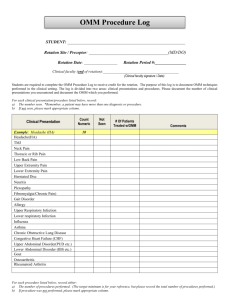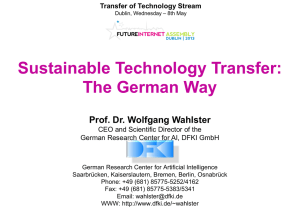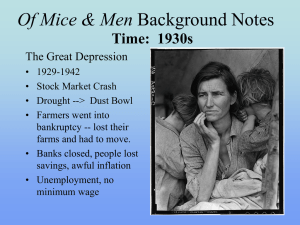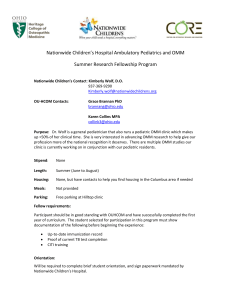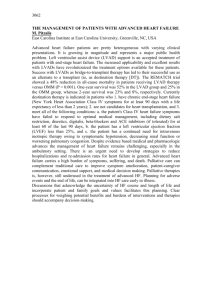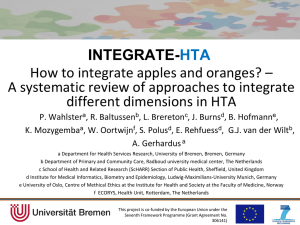Industrie 4.0: Active Semantic Product Memories for Smart Factories Wolfgang Wahlster
advertisement
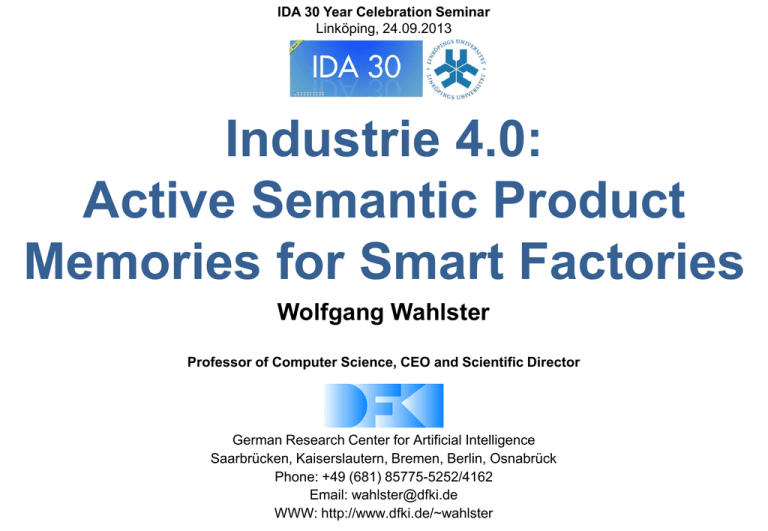
IDA 30 Year Celebration Seminar Linköping, 24.09.2013 Industrie 4.0: Active Semantic Product Memories for Smart Factories Wolfgang Wahlster Professor of Computer Science, CEO and Scientific Director German Research Center for Artificial Intelligence Saarbrücken, Kaiserslautern, Bremen, Berlin, Osnabrück Phone: +49 (681) 85775-5252/4162 Email: wahlster@dfki.de WWW: http://www.dfki.de/~wahlster Towards Intelligent Environments based on the Internet of Things and Services 5) Intelligent Environments 4) Embedded Computers 1) Central Computer 3) Smart Phone 2) PC, Notebook Smart Card 1 Computer Many Users 1941 1960 1 Computer 1 User 1980 Smart Factory 90% of all computers are embedded Many Computers, 1 User 2000 2020 © W. Wahlster The Smart Factory as a Network of Intelligent Objects Linking Products/Assets with Information from the Internet Capturing of Context Information Network of Intelligent Objects Context- sensitive Providing of Services (internet-based and real) Cross-linking of Assets and Products in the Factory Internet © Dr. Peter Stephan © W. Wahlster Degree of Complexity From Industry 1.0 to Industrie 4.0: Towards the 4th Industrial Revolution First Mechanical Loom 1784 1. Industrial Revolution mechanical production facilities powered by water and steam Industry 1.0 End of 18th Century t © W. Wahlster First Mechanical Loom 1784 Degree of Complexity From Industry 1.0 to Industry 4.0: Towards the 4th Industrial Revolution 2. Industrial Revolution mass production based on the division of labour powered by electrical energy Industry 2.0 1. Industrial Revolution through introduction of mechanical production facilities powered by water and steam End of 18th Century Industry 1.0 Start of 20th Century t © W. Wahlster From Industry 1.0 to Industry 4.0: Towards the 4th Industrial Revolution electronics and IT and heavyduty industrial robots for a further automization of production First Mechanical Loom 1784 Degree of Complexity 3. Industrial Revolution Industry 3.0 2. Industrial Revolution through introduction of mass production based on the division of labour powerde by electrical energy Industry 2.0 1. Industrial Revolution through introduction of mechanical production facilities powered by water and steam End of 18th Century Industry 1.0 Start of 20th Century Start of 70ies t © W. Wahlster From Industry 1.0 to Industry 4.0: Towards the 4th Industrial Revolution 4. Industrial Revolution 010001101 001010100 100101010 010010101 based on Cyber-Physical Production Systems Industrie 4.0 through Introduction of electronics and IT for a further automization of production First Mechanical Loom 1784 Degree of Complexity 3. Industrial Revolution Industry 3.0 2. Industrial Revolution through introduction of mass production based on the division of labour powerde by electrical energy Industry 2.0 1. Industrial Revolution through introduction of mechanical production facilities powered by water and steam End of 18th Century Industry 1.0 Start of 20th Century Start of 70ies today t © W. Wahlster Industrie 4.0: The Fourth Industrial Revolution © W. Wahlster Economic and Social Drivers Lack of Skilled Workforce Aging Society Volatile Markets and Cost Reduction Pressure ResourceEfficient and Clean Urban Production Dynamic Value Chain Networks Batch Size 1, Mass Customization Low-volume Highmixture Factories Shorter Product Lifecycles Increasing Product Variability © W. Wahlster Digital Production with Batch Size 1 Future Project: Internet of Services Using Internet portals to configure and order a personalized product Smart Shop: Make to Order Innovative Retail Software Smart Factory: Innovative Factory Software Tailored production: 566 billion variants of custommixed cereals from: Internet of Things Future Project: Active Product Memories Service-based manufacturing control based on CPSS © W. Wahlster Batch Size 1 Production of Complete Kitchens with Cyber-physical Production Systems Nobilia: Largest Kitchen Manufacturer in Europe 560.000 complete kitchens per year 2.600 kitchens per day 14 million variants Export quota 40% © W. Wahlster The German Future Project: Industrie 4.0 Industrial production is the backbone of Germany‘s economic performance: jobs direct: 7,7 Million. indirect: 7,1 Million, every second job more than als 158 € Billion trade surplus from export of industrial products (export : machine tool industry, automotive industry) Disruptive Paradigm Shift in Production based on the Future Internet 1. M2M and All-IP Factories are shifting from central MES to decentralized item-level production control 2. The embedded digital product memory tells the machines, which production services are needed for a particular emerging product. 3. Green and urban production based on cyber-physical production systems 4. Apps for software-defined products and smart product services Germany is preparing the 4th industrial revolution based on the Internet of Things, Cyber-physical Production Systems, and the Internet of Services in Real industry. © PG Kommunikation der Forschungsunion © W. Wahlster Boosting Successful Classical Key Industries by Internet Technologies and CPS-based AI Systems Examples in Germany: Automotive Industry and Factory Automation Two Revolutions: The Internet of Things and Services for the IP Car and the IP Factory Special Bus Systems (eg. CAN, MOST, LIN, FleyRay) in the Car Special Field Buses in factories (eg. Profibus, Interbus, CANopen, ControlNet, CC-Link, DeviceNet) Smart Product: SEIS & SimTD: Internet in and between Cars Industrie 4.0: Internet and Cyber-Physical Production Systems in Smart Factories © W. Wahlster Future Project Industrie 4.0 of the German Government Vision: Internet der Dinge Internet of Things Intelligente Umgebungen Intelligent Environments/Smart Spaces z.B. Smart City Smart City 500 M€ for 3 Years National Program: 250 M€ Funding of Ministry for Research and Ministry for Economics Evolution from Embedded Systems to Cyber-Physical Systems Cyber-Physical Systems Smart Factory, Smart Grid Eingebettetes System (ES) Networked Embedded Systems Intelligent Street Crossing Embedded Systems Airbag National Roadmap Embedded Systems Agenda Cyber-Physical Systems © W. Wahlster Outline of the Talk 1. From Embedded Systems to Cyber-Physical Systems in the Smart Factory 2. The Role of Active Semantic Product Memories in Cyber-Physical Production Systems 3. Semantic Web Services in a SOA Model of Cyber-Physical Production Systems 4. Industrial Assistance Systems Based on Digital Product Memories 7. Conclusion © W. Wahlster The Semantic Product Memory Stores a Diary of an Individual Smart Object. Sensors Multimodal Interaction & Browsing Black Box Event Recorder Semantic Product Memory Talking Product: Tells the Story of Its Life Actuators The Smart Product monitors itself and its environment. © W. Wahlster Four Hardware Realizations of SemProMs © W. Wahlster Products with Integrated Dynamic Digital Storage, Sensing, and Wireless Communication Capabilities I was produced on The product as an information 30 April 2010 and shipped container on 3 May 2010 – The product carries information across the complete supply chain and its lifecycle. Grasp at the middle The product as an agent – The product affects its environment The product as an observer – 2 mins open Please close! The product monitors itself and its environment © W. Wahlster Interoperability for M2M-Communication in Industry 4.0 µ webserver 32bit ARM processor 8MB SDRAM 100Mbit Ethernet &Wi-Fi LINUX on DIGI Connect OPC-UA (Open Process Control Unified Architecture) Server for M2M The heart of an industrial CPS: XML-based Web server or very fast binary communication based on the TCP protocols © W. Wahlster DFKI’s SmartFactory: The World’s First Living Lab for Cyber-Physical Production Systems © W. Wahlster CPS Hardware for a Digital Object Memory embedded or attached to a physical object Microsensor systems Radio Modules for Web Connectivity Microprocessor Memory Positioning Chips Actuators or Display Own Energy Supply or Energy Harvesting Unit © W. Wahlster CPS Software for a Digital Object Memory embedded or attached to a physical object Sensor Interpretation Components State Transition and Processing Logic Components Communication Interfaces Memory Management Functions Positioning Software User Interfaces Security Components © W. Wahlster From Bits and Bytes to Semantics driven by Software Engineering To semantic services driven by Electrical Engineering From bits and bytes common ontology Via functions SOAPprod_Core knowledge based Semantic Technologies driven by © W. Wahlster Closed-Loop versus Open-Loop Product Memories Ad-hoc Data Formats Semantic Data Formats © W. Wahlster The Structure of the Object Memory Model (OMM, W3C Standardization) Header Table of Contents Block Metadata Block 1 Block Payload … Block n Block Metadata Block Link © W. Wahlster Meta Descriptions for the Semantics of Payloads for Process Owners Block Metadata ID Namespace Format Block Payload Type Subject Payload of Process Owner M2M Creator Contributors Access History Title Description Verbal Description HCI © W. Wahlster OMM Semantic Web Memory Format Header <omm:omm> Identifiier <omm:header> <omm:version>1</omm:version> <omm:primaryID omm:type="url">http://www.w3.org/2005/Incubator/omm/samples/p1</omm:primaryID> <omm:additionalBlocks omm:type="omm_http"> http://www.w3.org/2005/Incubator/omm/samples/p1/ext</omm:additionalBlocks> </omm:header> <omm:toc>...</omm:toc> Block Description for Machines External Blocks <omm:block omm:id="11"> <omm:format omm:schema= Description for "http://www.w3.org/2005/Incubator/omm/schema/attributeList.xsd"> Humans application/xml</omm:format> <omm:title xml:lang="en">log event</omm:title> <omm:subject><omm:tag omm:type="text" omm:value="event" /></omm:subject> <omm:payload> <omm:attributeList> <omm:attribute omm:key="action">Transport</omm:attribute> Key Words <omm:attribute omm:key="begin">2013-01-11T19:03:00+01:00</omm:attribute> <omm:attribute omm:key="end">2013-01-11T19:04:00+01:00</omm:attribute> </omm:attributeList> Semantic </omm:payload> ... Content </omm:block> </omm:omm> © W. Wahlster From Bits and Bytes to Semantics driven by Software Engineering To semantic services driven by Electrical Engineering From bits and bytes common ontology Via functions SOAPprod_Core knowledge based Semantic Technologies driven by © W. Wahlster Service-Oriented Planning of Plant Systems Hardware-independent planning of plant systems ERP Enterprise Resource Planning MES Manufacturing Execution System Abstract Service hardware-independent Field Layer Service Library Device Control hardware-dependent Sensor-Service Valve-Service Pump-Service Control-Service Communication-Service Industrie 4.0: All-IP Factories, no chaos of field buses, Internet- based Factory Networking based on IoS and IoT © W. Wahlster Semantic Web Services for Industrie 4.0: The Semantic SOA Model of the Smart Factory Physical Model Functional Model SOA-based Smart Factory Ultrasound Sensor Inductive Sensor Electronic Stopper Function „Filling various drugs into individual pill boxes“ Function „Control quality“ Function „Fill“ RFID-LSG Function „Detect pill box“ Function „Stop pill box“ Camera Function „Count pills“ Service „hold“ Web-Service „stopper“ Operation: „hold“ IP 192.168.178.29 Inductive Stopper Sensor Stopping Unit Services: • hold • release • check Service Directory RFID-LSG Services: • read • write Ultrasound Sensor Service: • check Camera Service: • count_pills Nach D. Zühlke, DFKI © W. Wahlster The Smart Keyfinder with its Semantic Product Memory Chip Semantic Product Memory Chip in the backcover plastic frame with product specification Bluetooth circuit board with keyfinder logic packaged inside a plastic shell Personalized keychain with custom metal tag on the front produced by an engraving machine © W. Wahlster Key Components of a Service-Oriented CyberPhysical Production Systems Machine 1 Active Semantic Product Memory M2M Communication CNC Milling Machine … M2M Communication … Machine N Active Semantic Product Memory Production Service Discovery, Matching and Execution Workpiece Carrier 1 … … Workpiece Carrier N Active Semantic Product Memory Active Semantic Product Memory Production Pathplanning Based-on Semantic Product Memory Emerging Product 1 … … Active Semantic Product Memory Emerging Product N Active Semantic Product Memory Semantic Product Memory • • • • Top Shell Selection Circuit-Top Shell Packaging RES-COM Engravature Top and Bottom Shell Assembly © W. Wahlster The Intelligent Workpiece Carrier: A Complex Cyber-Physical System © W. Wahlster Dynamic Planning Based on Service Composition in a SOA Architecture for Smart Factories Green Fast Track Production Production Minimize CO2 X Abstract Process Specification Plug & Produce Conveyor1.transport (fullSpeed) (lowSpeed) Pick&Place.insertBottom (AssemblyPlace4) (AssemblyPlace1) (AssemblyPlace2) (AssemblyPlace3) Pick&Place.insertBoard (AssemblyPlace1) (AssemblyPlace3) (AssemblyPlace4) (AssemblyPlace2) Pick&Place.insertCap (AssemblyPlace2) (AssemblyPlace1) (AssemblyPlace3) (AssemblyPlace4) AssemblyPlace4.compress AssemblyPlace2.compress AssemblyPlace3.compress AssemblyPlace1.compress Adapted from Losykll 2013 © W. Wahlster Semantic Description of all Factory Components as Services in OWL-S Adapted from Losykll 2013 © W. Wahlster Plug&Produce based on Adaptive Service Ontologies • Plugin of CPS production components on a physical, digital and semantic level • Automated Expansion of the Service Ontology New Assembly Component is installed on-the-fly Adapted from Losykll 2013 © W. Wahlster Resource-optimal Production Planning based on Dynamic Energy Prize Schemes P ready – $$ standby 1 – Energy Prices standby 2 – off – Switching sequence t Measured Energy Consumption Factory Model Optimization Goal Function # devices i max ft fe e(a (i , d )) d 0 i now fw w(a (i , d )) fc c(a (i , d )) Constraints: w(i) : ! p(i) b min b b max Schedule: © W. Wahlster Start-Stop Control for Resource-Efficient CPPS Priced Timed Automaton Model Production >132 VA <1s Px <1s 2s Ready 132 VA [t1,t2] P=y [t1,t2] P=z Resource-Aware State Transition Model DEVICE STATE Process ET200 Sensor1 Sensor2 PowerUnit standby off inactive Inactive standby Off 0 VA 2s Standby High 129 VA 4s 2s Standby Medium 124 VA 5s <1s 2s X sensors power off motor standby 14s Standby Low 80 VA X motor power off Meta Description possible with Sandewall’s and Doherty’s Non-monotonic Temporal Logics based on Features and Fluents © W. Wahlster Location-based Industrial Assistance Systems in Smart Factories for Resource Efficiency Improvements © W. Wahlster Human-Centered CPS-based Assistance Systems for the Smart Factory Physical Assistance by Exoskeletons Mobile, Personalized, Situation-Adaptive, Tutoring Systems Context-adaptive Assistance for Fault Diagnosis Industrielle Assistenzsysteme AR/VR/DRAssistance in Complex Work Processes Multimodal Human-Machine Interaction Location-based Maintenance and Planning Assistance © W. Wahlster App Stores for the Smart Factory © W. Wahlster Advanced Industrial Assistant Systems Based on Augmented Reality Technologies Industrial Environment Industrial Worker with Google Glasses Tools Mobile, Interactive and Situation-Aware Tutoring © W. Wahlster Look-Through Technology Used in the Smart Factory © W. Wahlster Industrie 4.0: Robots are no Longer Locked in Safety Work Cells but Cooperate with Human Workers Today Tomorrow A new generation of light-weight, flexible robots collaborate with humans in the smart factory © W. Wahlster DFKI’s Fembot AILA: Using the Semantic Product Memory for Adaptive Grasping Stereo Cameras in the Head and a 3D Camera on the Torso for Approaching an Objectg Reading Size, Weight and Lifting Points from the Product Memory with an antenna in the left hand – the Robot gets instructions from the product being produced in the CPPS © W. Wahlster Most Recent Book on Product Memories in the Springer Series „Cognitive Technologies“ SemProM Foundations of Semantic Product Memories for the Internet of Things Series: Cognitive Technologies Wahlster, Wolfgang (Ed.) 412 Pages ISBN 978-3-642-37376-3 Electronic Order: http://www.springer.com/computer/ai/book/978-3-642-37376-3 © W. Wahlster President Obama has introduced the “re-industrialization” strategy for the US In the US, the great spike in unemployment over the past five years was disproportionately due to loss of manufacturing jobs. Innovation in Germany builds on legacies: in industrial specializations, workforce skills, and proximity to suppliers with diverse capabilities. The potential of German patterns extends well beyond defending niches against lowcost competition with incremental advances. They create new businesses, not usually through startups - the U.S. model - but through the transformation of old capabilities and their reapplication, repurposing, and commercialization MIT Taskforce on Innovation and Production Reports MAKING IN AMERICA MIT Press, 2013 © W. Wahlster Conclusions 1. Cyber-Physical Production Systems and Semantic Product Memories are the Foundations for Industrie 4.0 and introduce the Internet of Things into the Smart Factory. 2. The Semantic Product Memory controls the Production Process in a Distributed Fashion based on Semantic Service Architecture for Manufacturing Machines. 3. This semantic service architecture is based on a production ontology and ubiquitous microweb servers and realizes intelligent matchmaking processes between emerging products and production tools. 4. Active semantic product memories use semantic web technologies, agent technologies, resource-aware planning and scheduling and intelligent sensor interpretation based on AI research. © W. Wahlster Tack så jättemycket för alla år av vetenskapligt samarbete och vänskap 25 Erik Sandewall, Patrick Doherty, Christer Bäckström, Lars Ahrenberg, Nils Dahlbäck, Arne Jönsson 6th of June1998 10th of September 2003 © W. Wahlster Thank you very much for your attention. Design by R.O.
